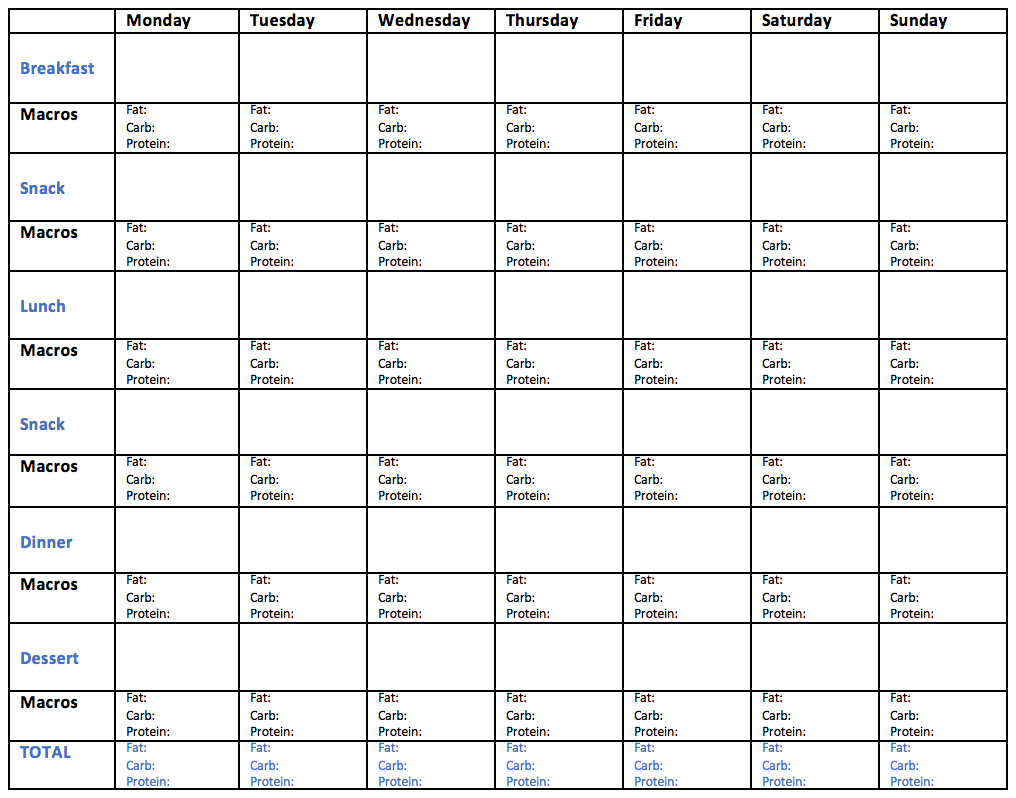
Low Carb Keto Friendly Meal Organization
Ideas to Make Low Carb Meal Preparation Easier
Make meal planning easier with these tips and tricks for keeping track of your low-carb high-fat diet.
Success with a low carb or ketogenic diet comes from a combination of discipline, patience, and organization. When you drastically change your macronutrient ratios (fats, carbs and proteins), planning can be an essential tool to help with your progress. Creating a meal plan for your low carb lifestyle is very simple, although it may take a while to get used to tracking your net carb and fat intake. However, like many goals, the more you practice the easier it gets.
In this article, we provide some tips for effective meal planning that will help you stay organized and motivated on your new diet. We have also included some simple recipes to help get you started.
Tracking Your Macronutrients
When creating a meal plan for a low carb diet, make sure you keep track of the macronutrients in each meal. This is what makes planning so great; given your desired macronutrient ratios, you can easily allocate them to the meals that make the most sense to you. For example, if you want to save your net carbs one day for a yummy dessert in the evening, then you can balance out the rest of your day with meals containing fewer net carbs. In short: a net carb count is a result of total carbs minus insoluble fibre (because insoluble fibre is not digested at all and is not recognized as a source of carbs or calories).
This is where apps and paying attention to nutrition labels and servings sizes becomes most useful. It may feel like obsessive behaviour at first, but soon you will become familiar with the net carb amounts in foods you commonly eat and be able to easily track your intake. Plus, you will see the benefits of paying close attention to your macronutrient levels which can help you make quicker progress on your diet. You will also learn a lot about different foods, and you might even be surprised to learn about the foods you were eating before!
Meal Planning
You can find several meal planning templates online, or you could even make your own using Google Sheets, or MS Excel and create a table with rows for each meal or snack and leave a small space under each row to track your fat, net carbs and protein. Each column in the table can represent a day of the week. We have created a simple template here that you can follow:
In this template, there are rows for you to jot down descriptions of each meal, as well as two snacks and even a dessert. Of course, you don’t need to use these extra rows if you don’t want to, but it’s nice to have the option to track everything in one place.
It is a good idea to keep your meal planner with you in your bag, notebook or on your phone, so you can easily update it throughout the day and check what you have planned. You could also place it in a highly visible area, such as on the refrigerator or somewhere else in the kitchen where you are likely to see it when preparing food. Having your macronutrient numbers visible to you throughout the day can remind you of your goals and keep you motivated to stay on track. Check out our Easy Guide to Counting Carbs for more information about tracking your macronutrients on a low carb diet.
Tips for Low Carb Meal Planning
Keeping things simple is key when you first start meal planning. This doesn’t mean that you have to eat boring meals or the same thing every day, but rather, don’t be over-ambitious during the first week and stick to recipes that you know are manageable for your lifestyle and budget. There are lots of great tips out there for how to save time and money with weekly meal preparation, and we’ve gathered a few of our favourite simplification techniques to share.
- Check your pantry, refrigerator and freezer for ingredients you already have.
If this is your first-time meal planning, we don’t recommend immediately taking to the web for a million new recipes to try out. First, see what you already have on hand that is compliant with your diet. Tackling new recipes can be challenging and time consuming and may require a few extra trips to the grocery store throughout the week. Instead, use what you have and budget one or two new recipes each week to keep things simple and manageable.
- Plan to use leftovers.
Leftovers are great for lunches and quick weeknight dinners, and they can save you a lot of time. You might even consider meal prepping large batches of food at the beginning of the week to help save even more time. You can cut and steam a bunch of vegetables, make large batches of low carb pasta or rice, hard boil eggs or cook a few extra portions of meat. This will make throwing lunches together a breeze and you can easily plan meals with these pre-prepared ingredients for the next few days.
- Use seasonal ingredients or sale items.
If you prefer to plan your weekly meals before taking a trip to the grocery store, be sure to check out what’s in season or on sale that week. This can be an easy way to find inspiration, and it is a simple way to save money and get the freshest products of the season! Since these items will naturally change, following the seasons and weekly sales are great ways to change up your weekly meal plans without sacrificing a lot of extra time or effort for planning and thinking of new recipes.
- Break out the measuring cups and kitchen scales.
One of the things that many low carb dieters find challenging when they first start out is portion sizes that are easy to track. It is easier with some foods, such pre-packaged products with servings sizes written on the labels, but things like raw fruits and vegetables and cuts of meat can be a bit more ambiguous. A simple way to make sure you are keeping track of portion sizes is to invest in a kitchen scale, especially if you plan to stay on a low carb or keto diet for the next few months or longer.
- Incorporate some flexibility.
Creating a complete meal plan for the week ahead can definitely simplify your daily life, but sometimes you’ll find that the meal you planned out several days before doesn’t suit your mood when it finally comes time to make that meal. This is why incorporating a bit of flexibility into your meal plan can help things feel less rigid. One way to stay organized but still incorporate flexibility into your meal plan is to come up with a couple of backup meal ideas. We recommend adding an extra section on your meal plan to jot down these backup ideas. This way, when things don’t go as planned, you’ll still be prepared and able to stay on track.
- Get creative and try new things!
If you are having trouble filling all the slots in your meal plan, it might be an indication that it’s time to try out some new recipes and get creative! There are lots of different things you can do to add a bit more variety to your low carb lifestyle and working in some exciting recipes to your weekly meal plans can help break up your routine and give you something to look forward to. Here are a couple ideas that you may want to try:
Explore the international foods aisle.
The world has so many amazing types of cuisine to choose from! By browsing your local grocery store’s international foods aisle, you can find flavourful seasonings, spices and ingredients that can help transform your routine dishes into something new and exciting. This is also a great way to expose your family to different cuisines and open the minds of picky eaters.
Let the kids plan a meal.
Feeding a family can get tough when there’s always someone who wants something different. Why not hand the reins over to the kids to pick a meal or two each week? Give them a few guidelines to follow and work together to either make the meal low carb compliant or make simple modifications for your portion of the meal. You might be surprised at what they’ll come up with and getting them more involved with healthy eating choices is always a good idea.
Follow these easy low carb recipes!
Lastly, we put together a list of fun and simple recipes that you can either use as inspiration or add to your weekly meal plan ahead!
Don’t forget to browse our huge selection of low carb foods to find any missing ingredients you may need to make these delicious low carb meals.
- One Pot Cheesy Taco Skillet – serve with low carb wraps or tortillas!
- Southwest Chicken Salad
- Steak with Keto-Friendly Oven Roasted Vegetables
- Low Carb Chicken Stir Fry Sheet Pan Meal – serve with Miracle Noodle Shirataki Noodles or Rice Substitute
- BBQ Chicken with Zucchini Salad (in place of a classic potato salad!)
- Easy Keto Lasagna
- Keto Sheet Pan Salmon and Asparagus
- Keto Chicken Pesto Burgers – serve bun-less or try one of our low carb buns!
- Homemade pizza with one of our low carb pizza mixes or crusts – great for a Friday night!
Get Started Meal Planning Now!
We hope that this collection of tips, tricks and recipes has helped you kick off your low carb meal planning with a sense of ease and excitement!
Let us know about your experience or if you have any other tips to share with our community on Facebook and Instagram. We also love to stay connected with our Weekly Newsletters for updates on the latest products and special sales. And please leave us a Google Review with your Low Carb Grocery experiences!







